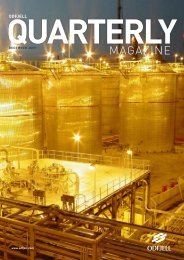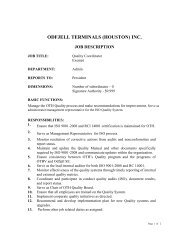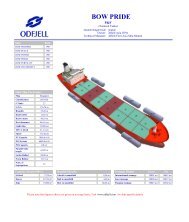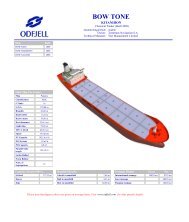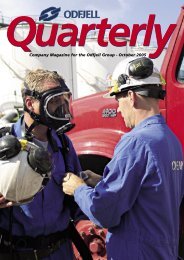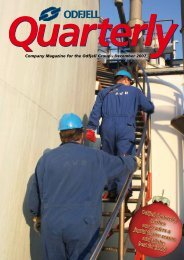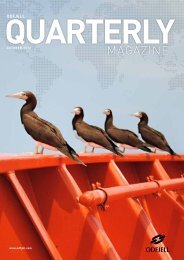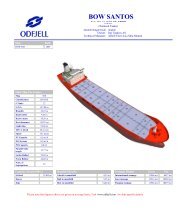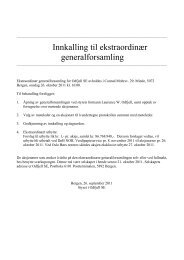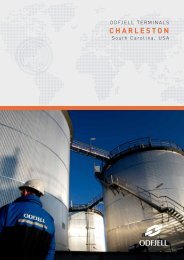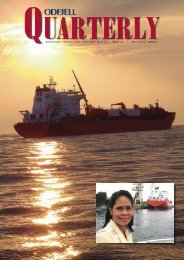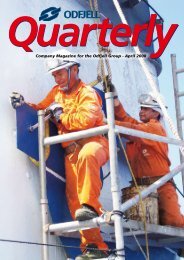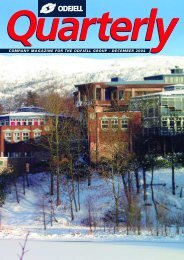Odfjell SE Annual Report 2012
Odfjell SE Annual Report 2012
Odfjell SE Annual Report 2012
You also want an ePaper? Increase the reach of your titles
YUMPU automatically turns print PDFs into web optimized ePapers that Google loves.
SUSTAINABLE BUSINESS<br />
IS GOOD BUSINESS<br />
<strong>Odfjell</strong> aims to achieve sustainable development for its<br />
investors, customers, employees and the local communities<br />
in which the Company operates by balancing<br />
financial results and corporate social responsibility.<br />
Safety is paramount and the Company actively promotes<br />
a sustainable proactive QH<strong>SE</strong> culture.<br />
Towards the end of 2011 <strong>Odfjell</strong> Terminal Rotterdam (OTR)<br />
experienced several incidents including vapour emissions.<br />
Some of the incidents were not properly reported to the<br />
authorities. OTR became a major challenge for <strong>Odfjell</strong> in <strong>2012</strong><br />
with regard to safety, operations, workload, personnel and<br />
the high level of scrutiny from the authorities and the media.<br />
Corporate Social Responsibility – CSR<br />
CSR Council<br />
In 2011 <strong>Odfjell</strong> signed up to the UN Global Compact programme<br />
and a Corporate Social Responsibility Council<br />
was established to facilitate gradual implementation of the<br />
United Nations’ ten principles within the areas of Human<br />
Rights, Labour, Environment and Anti-Corruption. In<br />
March <strong>2012</strong> <strong>Odfjell</strong> submitted its first ‘Communication on<br />
Progress’ report, which is an annual submission outlining<br />
the Company’s work to implement the ten principles to its<br />
stakeholders. The Communication on Progress report can<br />
be viewed at www.odfjell.com.<br />
Quality, Health, Safety and Environmental<br />
Protection (QH<strong>SE</strong>)<br />
General<br />
No incidents involving fatalities were recorded in <strong>2012</strong>.<br />
The lost time injury frequency (LTIF) indicator for <strong>Odfjell</strong>managed<br />
ships was 1.21, compared with 1.23 in 2011,<br />
and was the Company’s best-ever figure. The LTIF for the<br />
terminals was 1.33, compared with 2.90 in 2011, which is<br />
a very positive development.<br />
A number of successful measures were introduced in <strong>2012</strong>.<br />
These include risk management, investigation/root cause<br />
analysis training, competency improvement, Hazard and<br />
Operability Studies (HAZOP) and fall protection training.<br />
<strong>Odfjell</strong> Academy in the Philippines arranged nearly 11,000<br />
course days for more than 3,300 participants. About 2,600<br />
in-house training days were held for 1,900 participants.<br />
Two Officers’ Conferences were held in <strong>2012</strong>, one in Bergen<br />
and one in Manila, where topics covered included safety<br />
culture, crewing operations, risk management and a review<br />
of operational, performance and technical issues. A total of<br />
around 2,500 training days were arranged in the terminal<br />
divisions.<br />
Corporate QH<strong>SE</strong> audits<br />
Corporate QH<strong>SE</strong> conducts system audits on operative<br />
and staff units to ensure compliance with corporate- and<br />
management level requirements and expectations, promote<br />
a robust QH<strong>SE</strong> culture and to raise standards. 12 audits<br />
were carried out in <strong>2012</strong>, while 21 are planned for next<br />
year. This includes both owned and managed terminals<br />
and shipping units.<br />
Piracy<br />
Piracy is still a concern for shipping in many parts of<br />
the world. In <strong>2012</strong> Somali-based piracy in the open seas<br />
almost disappeared and activities in the Gulf of Aden, the<br />
southern Red Sea, the East African and Yemeni/Omani<br />
coast dropped significantly with no successful hijackings for<br />
several months. However, frequent suspicious approaches<br />
continue to be reported and privately contracted security<br />
personnel are still being used throughout the high risk<br />
area, which extends across the Indian Ocean from the<br />
north end of Madagascar to the southern tip of India and<br />
north into the Arabian Gulf and Red Sea entrances. Piracy<br />
activities have risen in the Gulf of Guinea, in West Africa, and<br />
have recently involved kidnapping and so-called extended<br />
duration robberies where the ship is sailed away and cargo<br />
unloaded. Kidnapping in this area is criminally rather than<br />
politically motivated and the time in captivity is generally<br />
relatively short. Robberies from ships, mostly in port or at<br />
anchor, are also increasingly being reported in the East<br />
Asia region, particular in Indonesia.<br />
Environment<br />
Carbon Disclosure Project – CDP<br />
In <strong>2012</strong> <strong>Odfjell</strong>’s response to the annual Carbon Disclosure<br />
Project covered the shipping business, Company headquarters<br />
and the terminals in Rotterdam and Houston.<br />
The total CDP footprint in <strong>2012</strong> was on a par with in 2011<br />
and the majority of the emissions came from fuel used by<br />
ships. There was a 4% increase in emissions from ships in<br />
<strong>2012</strong> compared with 2011 caused by a rise in the number of<br />
vessels in the fleet from 91 in 2011 to 104 in <strong>2012</strong>. The CDP<br />
score in <strong>2012</strong> was 68, which is close to the average score<br />
for all Nordic companies. This represented an improvement<br />
of 6.3% compared with 2011 when the score was 64. The<br />
maximum score is 100.<br />
76<br />
odfjell annual report <strong>2012</strong>



